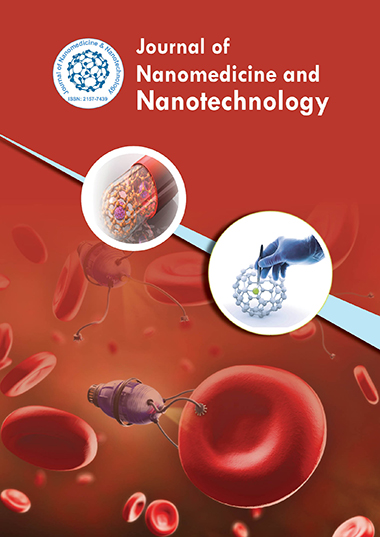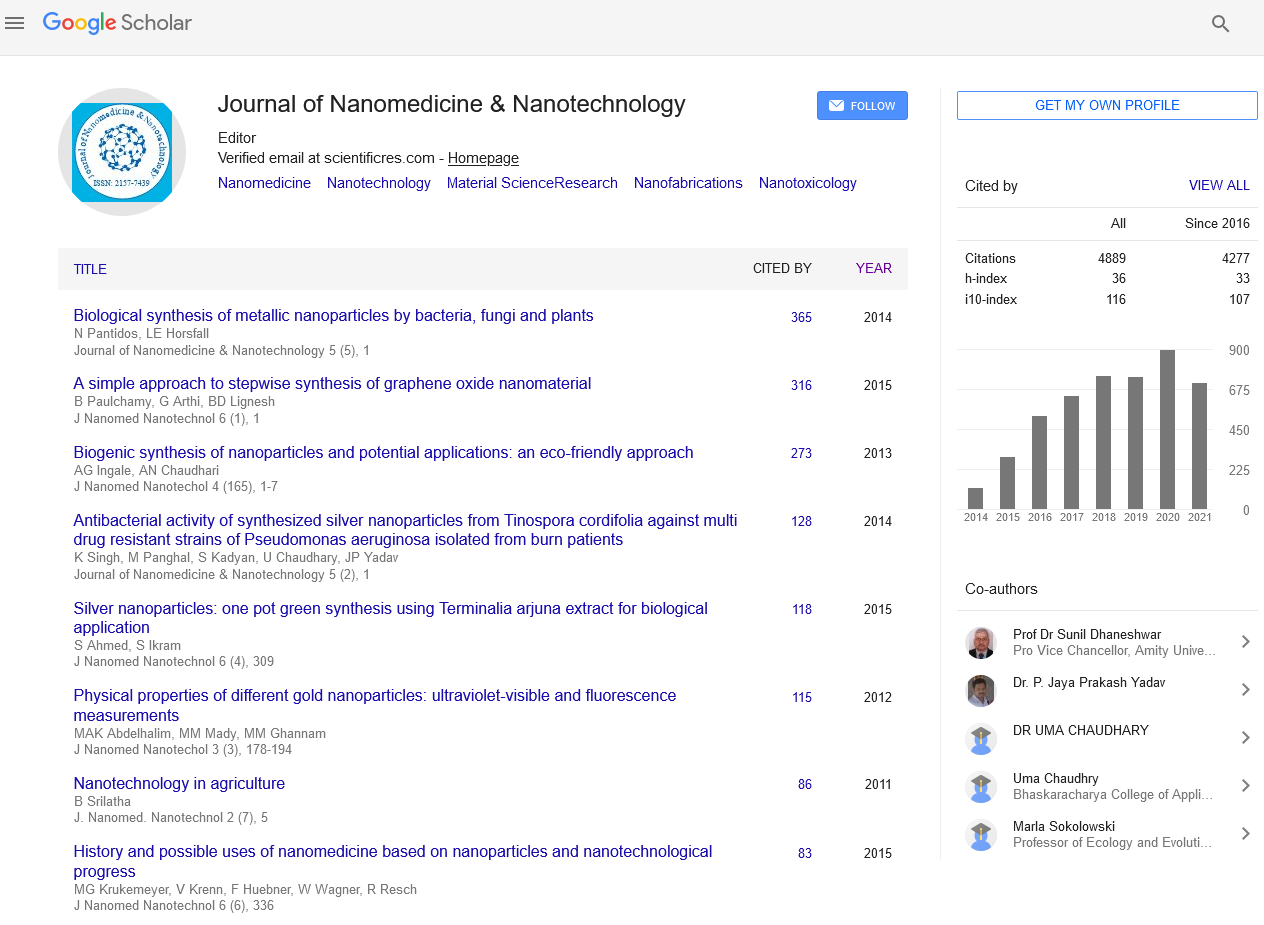Indexed In
- Open J Gate
- Genamics JournalSeek
- Academic Keys
- JournalTOCs
- ResearchBible
- China National Knowledge Infrastructure (CNKI)
- Scimago
- Ulrich's Periodicals Directory
- Electronic Journals Library
- RefSeek
- Hamdard University
- EBSCO A-Z
- OCLC- WorldCat
- SWB online catalog
- Virtual Library of Biology (vifabio)
- Publons
- MIAR
- Scientific Indexing Services (SIS)
- Euro Pub
- Google Scholar
Useful Links
Share This Page
Journal Flyer

Open Access Journals
- Agri and Aquaculture
- Biochemistry
- Bioinformatics & Systems Biology
- Business & Management
- Chemistry
- Clinical Sciences
- Engineering
- Food & Nutrition
- General Science
- Genetics & Molecular Biology
- Immunology & Microbiology
- Medical Sciences
- Neuroscience & Psychology
- Nursing & Health Care
- Pharmaceutical Sciences
Opinion - (2025) Volume 16, Issue 2
Nanoionics in Action: Enabling Next-Generation Electronics and Energy Devices
Everett Quinnell*Received: 01-Mar-2025, Manuscript No. jnmnt-25-28608; Editor assigned: 05-Mar-2025, Pre QC No. jnmnt-25-28608 (PQ); Reviewed: 20-Mar-2025, QC No. jnmnt-25-28608; Revised: 25-Mar-2025, Manuscript No. jnmnt-25-28608 (R); Published: 31-Mar-2025
Abstract
Nanoionics is an emerging field that focuses on the study and application of ion transport at the nanoscale, offering revolutionary advancements in next-generation electronics and energy devices. By leveraging the unique properties of ionic conduction in nanostructured materials, nanoionics enables the development of high-performance batteries, fuel cells, memristors, and sensors. These innovations are driving improvements in energy efficiency, data storage, and miniaturized electronic systems. Despite its vast potential, challenges such as material stability, scalability, and integration with existing technologies must be addressed to realize its full impact. This article explores the principles, applications, challenges, and future directions of nanoionics in modern technology.
Keywords
Nanoionics; Ionic conductivity; Energy storage; Solid-state batteries; Memristors; Fuel cells; Nanostructured materials; Electrochemical devices; Nanoscale transport; Smart electronics
INTRODUCTION
The growing demand for efficient, sustainable, and compact energy and electronic solutions has driven researchers to explore innovative technologies at the nanoscale. Nanoionics, a subfield of nanotechnology, focuses on understanding and manipulating ionic transport in nanostructured materials. This capability is essential for developing advanced energy storage devices, neuromorphic computing elements, and next-generation sensors. By enabling controlled ion movement at the atomic level, nanoionics provides new avenues for designing materials with enhanced conductivity, durability, and miniaturization. This article delves into the principles of nanoionics, its applications, challenges, and future potential in revolutionizing electronics and energy storage [1,2].
DESCRIPTION
Nanoionics exploits the behavior of ions in nanostructured environments, significantly improving the efficiency of electronic and electrochemical devices. Key principles of nanoionics include [3].
Ionic and mixed conductivity: The ability of materials to transport ions efficiently, crucial for energy devices like batteries and fuel cells.
Solid-state electrolytes: Materials that enable high ionic conductivity without the limitations of liquid electrolytes, improving safety and longevity in batteries [4,5].
Surface and interface effects: Nanoscale materials exhibit unique ionic transport behaviors due to high surface-to-volume ratios and interface interactions.
Electrochemical stability: Ensuring that nanostructured materials maintain their properties under operational conditions for long-term device performance.
These principles have paved the way for several groundbreaking applications in energy storage and electronics [6,7].
DISCUSSION
The impact of nanoionics is evident in various fields, particularly in:
Energy storage devices: Nanoionics enhances the performance of solid-state batteries, allowing for higher energy density, faster charging, and improved safety compared to traditional lithium-ion batteries. The development of lithium-sulfur and sodium-ion batteries also benefits from nanoionic advancements [8,9].
Fuel cells: Nanoionic materials improve ion transport in solid oxide fuel cells (SOFCs), boosting their efficiency and reducing operational temperatures for practical applications.
Memristors and neuromorphic computing: Nanoionic-based memristors mimic synaptic behavior, enabling the development of energy-efficient artificial intelligence (AI) and brain-inspired computing.
Smart sensors and actuators: Nanoionics enables the creation of highly sensitive sensors for environmental monitoring, healthcare diagnostics, and industrial applications [10].
Despite its promise, nanoionics faces several challenges:
Material stability: Nanoionic materials must maintain their conductivity and structural integrity over long periods to be commercially viable.
Manufacturing scalability: The large-scale production of nanoionic materials with consistent quality remains a technical hurdle.
Integration with current technologies: Adapting nanoionic components to existing electronic and energy storage systems requires compatibility testing and infrastructure adjustments.
CONCLUSION
Nanoionics is at the forefront of innovation in energy storage and electronics, offering unprecedented control over ion transport at the nanoscale. Its applications in solid-state batteries, fuel cells, and neuromorphic computing highlight its transformative potential. However, addressing challenges related to material stability, scalability, and integration is essential for widespread adoption. As research and technological advancements continue, nanoionics will play a crucial role in shaping the future of sustainable energy solutions and intelligent electronic systems, driving progress in both consumer and industrial applications.
ACKNOWLEDGEMENT
None
CONFLICT OF INTEREST
None
REFERENCES
- Cho J S, Hong Y J, Kang Y C. Design and Synthesis of Bubble-Nanorod-Structured Fe2O3–Carbon Nanofibers as Advanced Anode Material for Li-Ion Batteries. ACS Nano.2015; 9: 4026.
- Asoufi H M, Al-Antary T M, Awwad A M. Magnetite (Fe3O4) Nanoparticles Synthesis and Anti Green Peach Aphid Activity (Myzuspersicae Sulzer). Journal of Computational Biology.2018; 6.
- Esmaili N, Mohammadi P, Abbaszadeh M, Sheibani H. Green synthesis of silver nanoparticles using Eucalyptus comadulensis leaves extract and its immobilization on magnetic nanocomposite (GO‐Fe3O4/PAA/Ag) as a recoverable catalyst for degradation of organic dyes in water. Applied Organometallic Chemistry.2020; 34(4): e5547.
- Sandhya J, Kalaiselvam S. Biogenic synthesis of magnetic iron oxide nanoparticles using inedible borassus flabellifer seed coat: characterization, antimicrobial, antioxidant activity and in vitro cytotoxicity analysis. Materials Research Express.2020; 7(1): 015045.
- Iravani S, Korbekandi H, Mirmohammadi S V, Zolfaghari B. Synthesis of silver nanoparticles: chemical, physical and biological methods. Int J Pharm Sci.2014; 9(6): 385.
- Zhang N, Li X, Wang Y, Zhu B, Yang J. Fabrication of magnetically recoverable Fe3O4/CdS/g-C3N4 photocatalysts for effective degradation of ciprofloxacin under visible light. Ceramics International.2020.
- Liu S, Yu B, Wang S, Shen Y, Cong H. Preparation, surface functionalization and application of Fe3O4 magnetic nanoparticles. Adv. Colloid Interface Sci.2020; 102165.
- Mirza S, Ahmad M S, Shah A, Ateeq M. Magnetic nanoparticles: drug delivery and bioimaging applications. 2020; 189-213.
- Sorbiun M, Shayegan Mehr E, Ramazani A, Mashhadi A. Biosynthesis of metallic nanoparticles using plant extracts and evaluation of their antibacterial properties. Nanochemistry Research.2018; 3(1): 1-16.
- Singh J, Dutta T, Kim K H, Rawat M, Samddar P, Kumar P. Green synthesis of metals and their oxide nanoparticles: applications for environmental remediation. Journal of nanobiotechnology.2018; 16(1): 1-24.
Indexed at, Google Scholar, Crossref
Indexed at, Google Scholar, Crossref
Indexed at, Google Scholar, Crossref
Indexed at, Google Scholar, Crossref
Indexed at, Google Scholar, Crossref
Indexed at, Google Scholar, Crossref
Indexed at, Google Scholar, Crossref
Indexed at, Google Scholar, Crossref
Citation: Everett Q (2025) Nanoionics in Action: Enabling Next-Generation Electronics and Energy Devices. J Nanomed Nanotech. 16: 784.
Copyright: ©2025 Everett Q. This is an open-access article distributed under the terms of the Creative Commons Attribution License, which permits unrestricted use, distribution, and reproduction in any medium, provided the original author and source are credited


